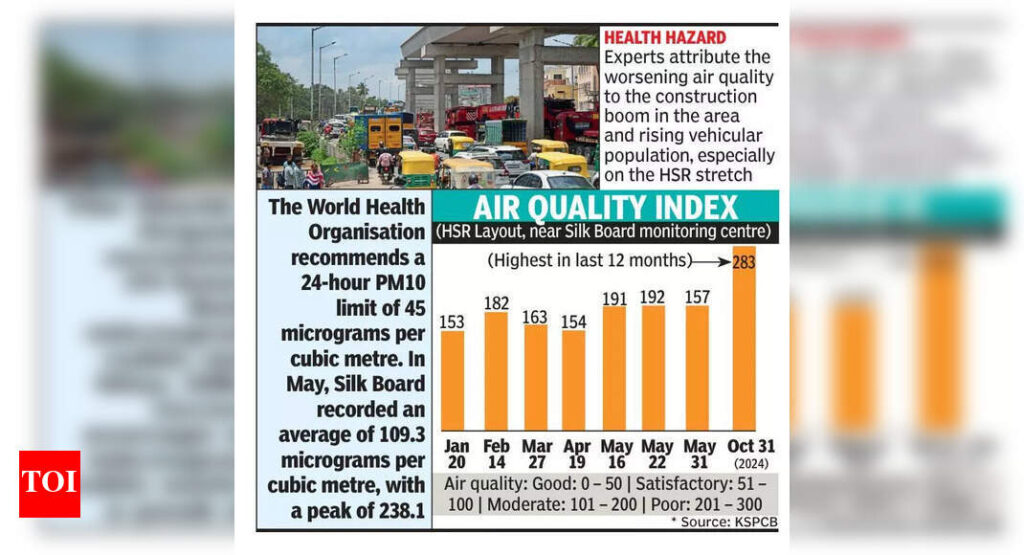Bengaluru: The Central Silk Board junction, notorious for traffic snarls, is now battling another crisis — alarming air pollution levels. Despite the completion of a double-decker flyover meant to ease congestion, pollution in the area remains dangerously high.Statistics from Karnataka State Pollution Control Board (KSPCB) show a sharp decline in air quality over the past few years. While the June and July 2025 data are awaited, the May numbers have already raised concerns.On May 22, an Air Quality Index (AQI) of 192 was recorded at Silk Board — close to the “poor” category. India classifies AQI from 101-200 as moderate, but several countries, including the US, Australia, Japan, Singapore, and the European CAQI (Common Air Quality Index) system, classify this range as poor.On Oct 25, 2024, AQI in the area spiked to 283, signalling serious health risks. For comparison, Delhi and Gurugram — India’s most polluted cities — routinely cross 200 between Oct and Feb.Though the Silk Board area hasn’t reached the levels of the National Capital Region, AQI figures consistently above 100 in the first five months of 2025 are worrisome. These levels persist even after the flyover construction ended, largely due to traffic congestion and vehicle emissions.“We don’t have strong restrictions on what kinds of vehicles run here. A huge chunk of old, non-BS-6 vehicles are still on the roads, including black autos,” said Aishwarya Sudhir, a Bengaluru-based air pollution researcher. She also pointed to the construction boom as a major contributor. “If you drive towards HSR, you’ll see many buildings coming up. Construction disrupts air quality and adds to pollution.”At Silk Board, the dominant pollutant is PM10 (particulate matter 10), mainly from dust, industrial smoke, construction, and combustion. Though PM2.5 is considered more harmful, doctors warn that PM10 also poses health risks, especially for those with heart or lung conditions.“PM10 still poses a risk in high concentrations or with long-term exposure. Many PM10 samples contain PM2.5 too,” said Dr Rahul Patil, a cardiologist.The World Health Organization recommends “a 24-hour PM10 limit of 45 μg/m³”. In May, Silk Board recorded an average of 109.3 μg/m³, with a peak of 238.1 μg/m³.Bengaluru has only 11 continuous air quality-monitoring stations, making detailed tracking difficult. With Metro construction ongoing and vehicle numbers rising, experts say relief is unlikely anytime soon.GFXAIR QUALITY INDEX DATA (HSR Layout, near Central Silk Board monitoring centre)* Jan 20, 2025: 153* April 19, 2025: 154* May 31, 2025: 157* March 27, 2025: 163* Feb 14, 2025: 182* May 16, 2025: 191* May 22, 2025: 192* Oct 25, 2024: 283 (Highest in last 12 months)GFX 2AQI categorisationGood: 0 – 50Satisfactory: 51 – 100Moderate: 101 – 200Poor: 201 – 300— Source: KSPCB
Trending
- Indore: Hams Sheikh rapes Hindu classmate, blackmails and harasses her, forces her to covert and marry him; arrested
- Centre Orders Probe into IndiGo Chaos, Sets Up 24×7 Control Room
- Why BJP is in deep water over a century-old canal project in Punjab, forced Arjun Ram Meghwal into making quick U-turn | Political Pulse News
- AI Slop Is Ruining Reddit for Everyone
- Brad Pitt’s Hitman Movie Is One Of The Most Underrated Crime Thrillers From The 2010s
- Huge Trove of Nude Images Leaked by AI Image Generator Startup’s Exposed Database
- Russian drone strike kills 12-year-old boy in Ukraine as peace talks kept under wraps
- German lawmakers approve plan to attract more military recruits that stops short of conscription

